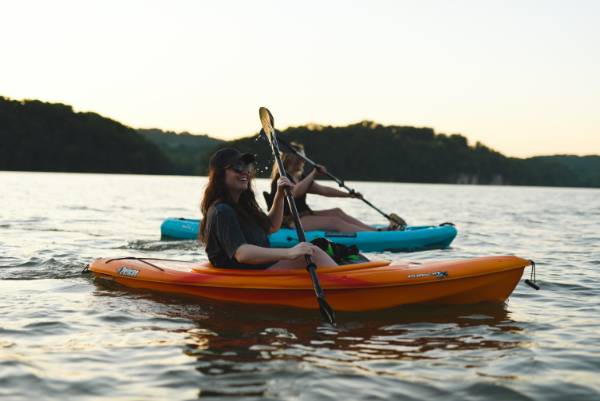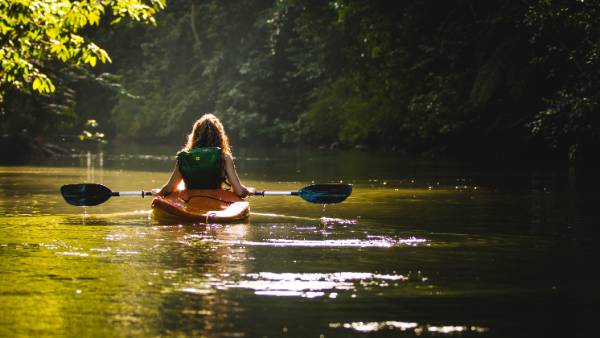Fishing at anchor from a kayak can be a great way to fish. A small plastic boat, however, will be swept away by the wind and the current like a leaf in a gutter. In any case, a kayak anchor will be necessary to keep you firmly in position. Read this article and learn how to anchor your Kayak.
Types Of Anchors
Anchor Pole
The first is a straightforward anchor pole. An anchor pole is a lightweight, 6- to 8-foot long pole that is used in shallow water.
You can use the pole by either pushing it into the mud or sand below your kayak through a scupper hole or by pushing it into the mud or sand a few feet away from your kayak and using a rope to connect it to your kayak.
Drift Anchor
A drift sock also referred to as a drift anchor, is a type of anchor that resembles a parachute and attaches to your kayak while slowly drifting behind you. A drift sock, which is typically used by kayak anglers, won’t hold you still but will reduce your speed in windy conditions so you can fish a wider area.
Folding Anchor
Four flukes on a folding anchor, also called a grapnel anchor, fold out when you need them and back in when you’re finished using them. These anchors are compact, weigh 2-4 pounds, and come with a bag for convenient kayak storage.
These anchors rely on a long rope and a horizontal drag along the subsurface. The flukes can then dig down and anchor themselves as a result.
Where the rope meets the anchor, boaters frequently add 3–4 feet of chain to help keep the anchor in more of a horizontal dragging position.

The best thing about having a folding anchor is that you can use it for your canoe, jet ski, SUP, or any other kind of small boat.
Bruce / Claw / Seahook Anchors
These anchors are made to be used on soft sediments like sand, mud, and gravel. They typically have three fixed shovel-style flukes that dig particularly well into soft ground. There are different weight Bruce anchors available, and 2 weights will cover almost all kayak fishing situations:
- 1kg Bruce Anchor: suitable for depths up to around 100ft, low to moderate tidal flows, and sandy/muddy/gravelly grounds.
- 2kg Bruce Anchor: suitable for depths up to and over 100ft, moderate to fast tidal flows, and sandy/muddy/gravelly grounds.
Mud Anchors
These are essentially heavy weights that are heavy enough to sink into the soft mud commonly found on lake beds, ponds, canals, and reservoirs. They are very popular with still-water and freshwater anglers.
Their weight alone can stabilize a kayak on the harder ground in calm conditions. They can also be used in shallow saltwater in low-flow areas, and they are especially helpful over very rough terrain because they don’t snag as frequently.
How To Attach An Anchor To A Kayak
One of the most crucial abilities to develop is kayak anchoring. The kayak could flip over if it turns sideways in the current or wind, and the angler could get tangled in the line.
Learn how to anchor a kayak, then put your newfound skills to use to create safe procedures to prevent this outcome.
Before entering the big water, practice these moves in controlled, calm conditions.
- On the kayak’s deck, coil the rope loosely to start. Quickly fasten the line to the carabiner on the anchor trolley after dropping the anchor overboard.
- The anchor trolley should be moved to the bow or stern as the line pays out. Continue releasing line once the anchor touches the bottom until you have about twice as much line out as the depth of the water.
- Allow the line to tighten while holding the anchor rope. Release more line if the anchor drags. Set the rope in the kayak after the boat has stopped.
- A tiny plastic cleat is an ideal tool for tying off the anchor line. Use a jam cleat to hold the line for a discrete connection that releases quickly. Being able to quickly and smoothly release the anchor is a crucial factor to take into account when tying an anchor to a kayak.
- Start by making room on the deck for the anchor rope before pulling the anchor. Pull the rope until the kayak is directly over the anchor, then loop it on the deck. Retract the anchor trolley after that, then drag the anchor out of the sand and into the boat.
How To Anchor A Kayak At Sea
Kayak anchoring is nearly impossible in the choppy ocean due to the swift current and deep water. The choice to anchor a kayak over a reef or wreck is up to the angler. Use a kayak wreck anchor to securely fasten the anchor line to the reef without getting caught.
Four wire spines are inserted into two pounds of lead to create this anchor’s spines. Let the spines catch as you lower the anchor to the wreck. Pull firmly to release the anchor when it’s time to move on and the spines will bend back.
How To Anchor A Kayak In Rivers
It’s particularly challenging to anchor a kayak in a river because of the strong current. River anglers secure the boat with a drag chain to prevent it from becoming stuck in the rocks. River anglers pass the rope through the stern of the kayak directly rather than using an anchor trolley.
The anchor can be pulled and deployed quickly and easily thanks to this rigging without running the risk of flipping the boat over in the current.
How Much Anchor Line Should You Let Out
When the anchor line is at a shallow angle to the bottom, grapnel and Bruce-style anchors will best bite into the bottom.
By decreasing the angle between the anchor line and the anchor, you can increase the holding power of the anchor and lessen the likelihood of anchor slip by increasing the amount of anchor line let out.
How much anchor line you need to let out will be largely determined by the weather. The greater the wind, the greater the swells, and the faster the tidal flow, the more anchor line you will need to release.
In shallow calm waters with little or no flow then you might get away with hardly any extra anchor line out as there will be little resistance against the anchor or mud weight.
In calm-to-moderate tide/wind/swell conditions you should be able to get away with letting out somewhere between 1.5 to 4 times the depth of water.
In faster tides, strong winds, or large swells you may need to let out over 4 times the depth of water to achieve the shallow angle required for the anchor to hold effectively.
Where To Store The Anchor On A Kayak
The weight of an anchor makes it more difficult to pedal or paddle the kayak. Keep the anchor close to or under the seat and in the middle of the kayak for optimal balance. This puts the anchor’s weight closer to the angler’s weight, where it will have a smaller impact on the kayak’s performance.

